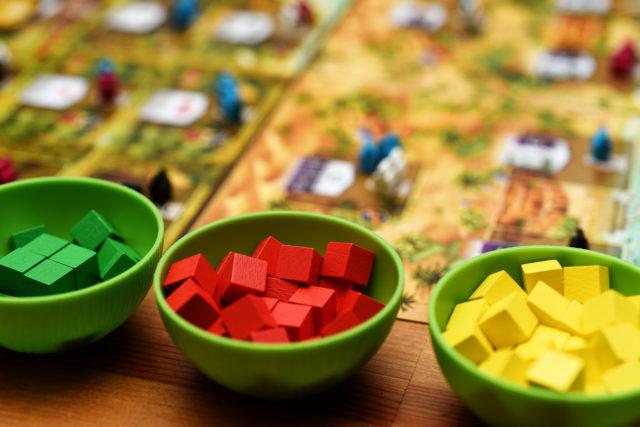The trilogy is complete: we have reached A New World. Back last September when I wrote about the second game of Emerson Matsuuchi’s ambitious Century triptych, I speculated that the last game would involve bidding or stock-holding. Welp, I was wrong, but I’m not sorry I was wrong. Century: A New World (C:ANW) is a worker-placement game, and in retrospect it was probably the obvious choice–not to mention easier, from a design perspective.
The first game in the series, Spice Road, was perfectly…adequate. Basically a take on Splendor: build a card engine to generate the cubes necessary to claim VP cards as quickly as possible. Eastern Wonders introduced a spatial element: now it was island tiles instead of cards which supplied the generative actions. Plus, there was an outpost mechanic whereby building huts on all four types of islands unlocked powerful upgrades. Much more interesting on its own, and the combination of the two worked well.

In C:ANW players are once again in an efficiency race to deliver packets of goods, but this time instead of cardplay or movement around a modular ocean, players must plop some teeny-tiny meeples down onto a spot to take the cube-generating, upgrading, trading, or cashing-in action. Every space has a minimum requirement of dude/ttes, and if you run low you can instead take a turn to bring them all back home.
There are several neat twists. The first is that you can kick someone else (not yourself though) out of a space if you want that spot, but you must ante up an extra “colonist” to do so. So if there are two there, you must displace with three. The second is that at game’s start the more powerful action spaces are unavailable, and are only freed up when someone claims a reward card with an icon that enables them to do so (and get a tiny extra bonus as well). Since it’s the claiming player who decides which space to free up, every game will progress differently.

Finally, although the reward cards in C:ANW have substantially fewer straight-up victory points than the previous games in the series, there are major possibilities for set-collection VP via icons on the cards. This is made more challenging in three ways: (1) players can only get these VP if they have the matching scoring tiles; (2) these scoring tiles can only be picked up when you deliver goods to market; and (3) you can only ever own three scoring tiles max. Since the order of appearance of both reward cards and scoring tiles is random, timing is even more of the essence.
I must say that each game in the Century trilogy impresses me more than the one before, and each would make a perfectly good game in its own right. Ah, but the combos…that’s what I wanted to check out.
* * *

A New World comes with separate (but overlapping) rulesets for combining it with Spice Road and Eastern Wonders, both individually and together. Naturally, I was most interested to see how all three games worked together. Worker placement still drives gameplay–it’s just that there are extra spaces which allow players to either draw Spice Road market cards as one-time actions (plus, for every four cards you take, you get to draw a New World bonus tile) or move their ship around a reduced Eastern Wonders archipelago (with the possibility of unlocking other New World bonuses when you build enough outposts).
The result is not unlike a Feld game, but more integrated. It’s a point-salad, with several possible routes to victory, but ultimately it’s still all about building the most efficient engine for generating and delivering cubes. It’s hard for me to guess whether the combo game would have sustained interest on its own merits had it been released as a single game rather than a trilogy. I think it would have…but in game design terms it’s much more interesting the way it is, sort of a deconstructed Euro. Whether it will stand the test of time as a good game or be relegated to the back of the shelf as a curiosity like 504 we’ll have to see.
Meanwhile in related news, publishers Plan B Games have just announced they are going to release the Golem version of Eastern Wonders, called Eastern Mountains. One can only hope the whole trilogy will be Golemized soon!
A review copy of this game was provided for this article by Plan B Games.
Comments
No comments yet! Be the first!